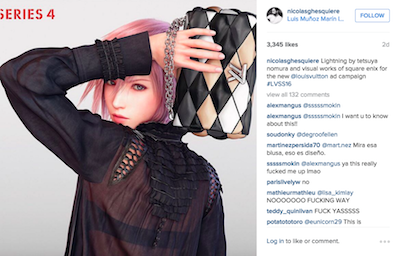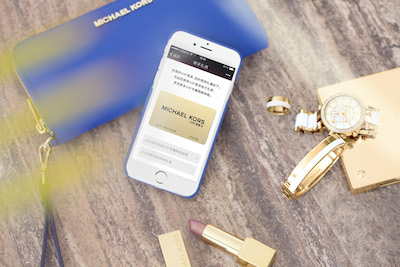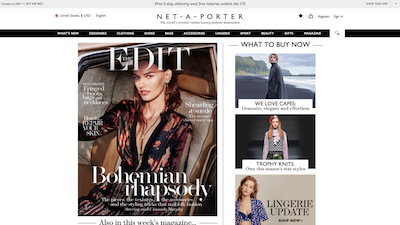The luxury conversation occurring across social media channels has increased by 75 percent year-over-year, according to a new report by NetBase.
NetBase’s “Brand Passion Report: Luxury Brands 2016” monitored social conversations to determine what was mentioned most frequently, finding that watches, ecommerce retailers and European brands took up much of the luxury banter online. Understanding consumer interests can help luxury houses formulate a social media strategy that works to engage and interact with enthusiasts by keeping them up-to-date on brand happenings, products and services.
"Key drivers for the increase in conversation are due to these brands' aggressive imperative and investment in social media and additional social media channels as part of the omnichannel strategy," said Hope Nguyen, vice president of marketing at NetBase.
"An industry breakdown of the luxury conversation: fashion and handbag vendors account for more than a third of the NetBase Luxury List this year, followed closely by automobiles (31 percent) and jewelry and accessories (13 percent)," she said.
"As top channels and blogs go, Twitter and Facebook dominate the social channels on luxury topics, with Luxury Daily and Business of Fashion among the top publications that drive the conversations."
NetBase’s second annual Brand Passion Report: Luxury Brands 2016 looked at more than 700 million English-speaking posts across luxury, watches and ecommerce. The social posts observed spanned from more than 80 countries from September 2014 to August 2015.
Social chatter
During NetBase’s observed timeframe, the conversation for the top 45 luxury houses, determined by social mentions, increased by 82 percent. As for the top 15 brands, which include the likes of Chanel, Gucci and Hermes, this segment more than doubled their social conversations.
Not surprisingly, 50 percent of the top 45 luxury brands included on the list are European heritage houses while only 30 percent of the labels are based in the United States. Ten of the top 15 brands have European origin with most being from Italy and France.
France’s Chanel dethroned Louis Vuitton for the number one spot, with Italian fashion label Gucci taking the second spot. Chanel saw a 152 percent change in mentions on social media raising the atelier from third to first, while Louis Vuitton dropped from the top spot down to number 7 with a 29 percent change in social mentions.

Louis Vuitton, Series 4 campaign on Instagram
Consumer electronics brand Apple also made an impact on the top 15 brands, with the brand itself being placed at number four and its products the iPhone and the Apple Watch ranked at 11 and 13, respectively.
Although not a specific brand, vintage appeared in many social conversations in relation to luxury products. The rise of online consignment marketplaces and investment opportunities of high-priced luxury goods likely helped position the term at number eight on the brand ranking (see story).
The mid-ranking brands taking places 16 through 30 include brands such as Ferrari, Jimmy Choo, BMW, Kering, Net-A-Porter and Dolce & Gabbana. Net-A-Porter is a newcomer to the list, along with Chinese online retailer Alibaba, but NetBase also tracked Amazon’s movement from number 31 to 20.
As Amazon’s penetration into high-income households becomes increasingly apparent, luxury brands are going to need to find new ways to avoid losing to their online-only competition, according to a report by Shullman Research Center.
Through pricing, convenience and selection, Amazon has seen its popularity skyrocket over the past two decades, and data in the report shows that its popularity is positively correlated with household income (see story).

Michael Kors using WeChat
NetBase’s ranking was rounded out by Michael Kors, Porsche, Tiffany & Co., Mulberry and Jaguar, who took spots within the 31 to 45 bracket. Newcomers included Montblanc, Richemont and Rolls-Royce, who took the final spot.
For the report’s second edition, there are a few brands that made the top 45 during the year-ago observation that did not make the cut for this year’s ranking. These brands include Versace, Moet Hennessy, Fendi and Giorgio Armani, as well as Apple iPad, the sole U.S.-based brand to not recur.
Department store woes
Four department stores were not listed in the second edition of the Brand Passion Report; these included Neiman Marcus, Hudson’s Bay Company, Barneys New York and Saks Fifth Avenue. As it stands currently, traditional department stores are fighting to maintain relevancy in a consumer climate that is shifting to digital more and more.
As department stores find themselves facing increasing pressure from ecommerce-only players, a seamless omnichannel approach will enable them to remain competitive, according to a recent report from L2.
With declining traffic and loss of market share in a more crowded space filled with mono brand boutiques and large ecommerce players, department stores have to leverage their in-store capabilities with their online channels to capture sales from consumers seeking a seamless, hassle-free shopping experience. From opportunities to upsell at point of return to allowing for varied purchase paths, bricks-and-mortar retailers can use their physical locations to their advantage (see story).
For online retailer Net-A-Porter, who did not appear on last year’s Brand Passion Report but placed at 28 in the second edition, the struggles of its bricks-and-mortar peers may be beneficial for its business.

Net-A-Porter homepage
NetBase found that Net-A-Porter’s mentions increased 1.4 times from the year-ago, with the retailer maintaining strong in terms of “passion intensity” and “net sentiment.” Net-A-Porter’s standing in the “love quadrant” was driven by its connection to “favorite” moments determined by its marketing and the popularity of its magazine, Porter.
The strength of online retailing is evident in Net-A-Porter’s record sales over Thanksgiving Weekend.
With an order placed every 1.4 seconds and one item sold each second during Cyber Monday, Yoox Net-A-Porter had sales growth of 50 percent to kick off the holiday season. Of purchases made, 41 percent of consumers did so using mobile devices, showing the importance of a well-rounded ecommerce platform (see story).
"Great brands master the art of creating an emotional connection with their consumer, which to a large degree removes price comparison as a deciding factor," Ms. Nguyen said.
"But first, they must have a deep understanding of the role their category and brand play in the consumer’s life, and how they can stay in sync with consumer dynamics," she said.
{"ct":"OheN4Uc\/mmSwzgbxg+0HdVJ95vPoNSNYPS59HHS1mhEdFy1ZoojurcEBl83R53fIFt71zD6RlbtFM32IedJbcAdPW1gAO3GkHo4myWShLjJIPdvn6tCI5rSo0Nwd57t7WuhDwilFhJuEnyOiWm3YoJmdMjJ6j4YYJGO91RpTdGaMSP37WZdWMGu+e2mb5bMfMna9PLUc6YADwv7OLA96sWwfHbUA6CprqKZQHIDipDS2F9ML3pDFf0s+afEGskybr3ow2SKEFT9K3JQtYwbHL4viHlg\/4hiousPpgkYxegG87qbBj45jHRr5s3rBRYZxVwDm\/wElxGDwEfUa0MhrEmpmEQMM1unAcrhIWJ2M1IAfWdYCGceur3+GPpy+UrPM\/6rZTDfp181CmLUBPsLEdF5CiMh4rvfijNb1wxBT1Il5cwTO\/x2gS6OT7IMxoaJ58on8BPdJP1edB+fmv0PIk5EqE6o4Q5VjY\/XvS+DdNaFQzkWrnqnU7+0dVI\/lYr43oov6DR9LQmNQ6WxsGPVxPTwObn01dZCOMSrenbc6xB\/RslaxI+\/\/RuM\/KEy534bZnyf9Bw9sGE6PlylqPavkdCDcwKH+Ccu0zdiimBsnaTw9l1QpLwk8ntbjkh7035oRWnNlnjssqUnrR1Z2W4ajbS5UjzUtS8nMQtjuvs0sN5ORLQYeQij9rr+bxjeRrHBELUKUm4vFbFCnR7MEDtOGaNhT4zPDdj8Tec34W3uGcrrtZhD7OpOIyrOZ1DSx6Dyz9TrFePrnLHTaQoOMBZ1oa1Fi9bNtsHxMJnU93Vj\/te9AS3vwxLdefh7yi0R9clZoIgEr9LZ2pg0fnhVPhAvJ8SE7AKwZfobnfFWUF6ta3phj+bGgmSsbv3Xglf9yI\/fzD0CotXkhTb88dOPE+0iFwaX+H6cj7dgR0bsDWRTY40bo9ss2r4XrWJWOEt5mrz4A\/iGljjlBupxAHUtiQymjjVICYC\/oHsX1TiDPXWTQTuTJ6CdrT4jy0nPsY9XX92T3RG7TN0+htrUxhaIM8\/bzjjJWd9c5z1WiOejw2HTgxOsyVlKZ4PseDwsqFFJdA6m5Dv8167Y5IQFHjRrV3xUffUEAHDspRe0nya9ZnPXM8zLgoUZkN8XBCG7oFhrPjKjO9F+AW\/0p7Hta1gj42AHL1sm42JJVnUGL6qAVZwzuqMOesLxwBI+EeUHL\/X2IJ6Sscb9iHJ0W3nW0lNnLmzkNAi2NYVsCPLHDGJgnwGPjVkd9MPJryDh9GnmApjIfFpw2c\/idg7RLQ2zrGsGHY\/QIe5rue4ii5hmpH689Ey3414PFs+vmxI1TRgGaoPJS3CKnaC5yg0I+\/N2Vouu3fkzxjX1cugHHIcjuyvkNlY\/MQ4h5ht984cACw8m4RAS+vjXG8CaEohCqFm1lZmIERI\/c9xF98ZsysO7wgdTtp1s+CFcyYRqww4cX\/lyt6MdX3GmYSQcYmR2fwlVsvTsGTZBPIYWnIvtTWN5SOsSYfD9v7yzD9KxT8UCIcgg1vr+nxjpR1s4sxnG23z9w8G05I+WWqkN62GKreIen6pyUWGGQQQS2i2l0wOe0XH4e\/Ip6\/mFnhgm75jJ0tBGPoToYHEL6MGZTSVtAwiEwdA\/u2QYF3vAbgDwVVbCCd2HqKD4bsx5n3aKqY8a7cSgtrrVggCwRHWIJze+92DwnhNcURy4LnRUqrie3MNmeFuHTRCmGZ9HxI+kWjneDvEDSLGMU5tDXT76qq+e9XIio1EN3gXmay4g7s2+o3JG2VGky0D7jZZaZ41qw+BEYmwcBaMw4C86fnG9tQg2+FeNrjEGxq0KoWx1SmVFmuiSROviwTpOxdT0lVx1Tt3kmBD1uCaNJiExroud\/P7z1iVr7GN6NqBvTdzDO6KNfiLTA80Hfwbgoo7W7Tl20EBH6NADir\/PRxentdKucxbFO69mlFayI+cHT5\/K9zqDq1biIVIh5+5NDWTuvBIF6DyoXWs3Ouxo3jsJMf9P2wFdoFzVsVBKjK\/RpBG\/hM6c719xGe+eOvcu2MxRrz\/uwG7VCKI1oUhA4l9raDdH6h1nAmbu2a5pB5F76MAc6xDCNMqm+mkSGx3YBCsCHvmOrYflprrAW3lukF3eVnSBLjflxWT+o5LadrHuJoyiV8ob\/t2WLwliMx8h9o9U3tEOSnWhmVEU\/m3YxuMY4TNZzh\/40X6PbtRzeQt6GUB5NNP5PWok224Em8loHwEEvcueX1TJqRQs67GsU9JGeXNHFuVoUpUaFvWTTuonMMcpwmw7KEHLief1nfqb0AqUhjxPdCP4tKRX6\/vSNsQKcd+3U6JrdX8teleTtW7LBkd56vqLVREQlyJU+ZrFx8p26UDJmJIha2d67ZoqEqY9hBFvBa2O7vNHCEFcY2SxGq+lDW90yAQJ\/jESpeQfme85ielcvWofamQm1sbtEKUgGOtdcB2ePEP4v7m\/2lvhyYZVaAwO6ZyOz6cgaOpl\/x+dUwVdHRI+x4jNRyqc9KUKAKWUzghqy5fPdzf4\/+7GB+DuSt6RHXI29gpTguS+4l5LGVVq7j26kp0EYjetzca8h37tqCGJkpKvugAW2kQpf0cJUm9tiJD\/65LoXifOF+WOqYKddysVI9BF+J79HC4lcSqBpQREDl7bWTwrZmxjGExhABzRdOD9x3uAFuh34dd1d7cFiE8t832YCx13yllXCT+pLwvPP\/J4PArtUBciFf26oQa4v0AC6voIh3RYlhuM0lP1sagLvlAtjxRH2w+PY2S+PF8LvWVJ7ud6\/jToo6650ryMm\/sK1Vc1UGMvwD1K+xIo9wxOdqOIRYevXchtUoVoXoKxwnK5IUVImBSCcVmOoAi9ct9aOOsPVxyJLKyzPOvhyUcdOY7mX22gUgDNuxhUfawewh1PlKBbT7\/mPLCvoQiocWyZo6eVMgiMfodzMPxT4b7VpC9OpZW\/O+rWuLYGgY4IncI1GmJ9X500\/HQ\/kPncRwQIbsYdLx\/xQqLy6dGZ3WvcHfKi00DMXysBkotTxCBqzTDvtZWGxVEBpXDUlEP+gyR0unhscsVzgFmOG3Zo6a3Ab0RwkS8VsNU5Sf8DUh5ZvA2cNmi3ImXRkL5b+\/zqF7whqV26q78CwPyjRd9HbHAd3VMNbtfF2FM3FSY3FrJJdEApr9GJ1Dz4Q2ch2Am4\/3aaE68tIE\/IbV0S7yFVz0ctjdg7yAy+9CyHvTTYlXyx9SEPuIlsDFbtq2kKLWShoktDgJNRNJBu5D9xUQv4wu0NeuS0RHBb\/pXeY4KBBmHLCpPGZO7mN689cTs19CCoPiij3SdyaTgapuWkH9DyVqSHGNRARw1pEJP45Gg3gVyCbkxSnHTNX1grIUccfBevks22z0kRKZDNE4\/xKABQUYBfBI9Sv2g6c4nOZxTqg5nxms0EE4wwPycoouMgp40r4KcMMBdRRVHAkZ9rIWCSrssFmg3xx8cpUXwmYB8yae0wrDPmWWJUqO7mAateycQaCTjROx4yHyQ7JJCMFrdTPuO9BZGz3++Ngzso6SoRWkQlxbA+sTKFy66lFtU5yV50Ocvk+Yve1\/QNeYqOSQb33+lZrTtmKa\/Fgf4BCPO3eFR9eBAxBGuKk5NyVC+zXn7XVfW60hQKfXvEyOvaLUPW9CqhZvU9HsisTt6GADQ1UCXhTBrlEVaWrVpnO\/nBdjk9lHdqNw3eBGX\/lgl\/Qczbh7NVpvn9bOc\/x0HgNWijNNm26WgEnETSgLLodyd+35LPbjnkXX7Go\/TfO6RlRUa53KzIezOeIir+g8duWi6oaK2rpaGfPzsiyWqhMkT2UOBc\/SMMDD6P\/HRUzZwrmggvLew9chAZLuJ1mrojLDTm2YxBwxpAZCB9IkzrJ0PUoOuIvWiZs9cY59J3ueofbP9QwEHtBiE18dDK9Z6qmwgHSbSWpzXSBE\/uvsNYsKiU6PRetOlMHHgtm7z2EK7U7J1Tc2y8gQHiAPKBna7x077Y5JD7v0mTYh9O\/hQXzEiL+v3VVA79bzz3rvyVdrHXhLPoL1wxM5nc2pKsgaAAXUd8Q9MDcHXzWQ3oduJUmAIIiSiJnpSq8Y8dwSuCV40w5ePOIFn7GK713ljC9YYcC1ZPBbS5mCd2\/TcStSLZcU22kM\/EF+TPdOUtpfqxPxH9Yz7RE8uZ3oJicZZNzerbQk7C\/JRNcWCLKvLTDmJM9ETQh1SQ4YkvrAgKkCB8CBc3PcIWf+clFRjtN2bouOOGzwNB8VK62FpgKPi6nFres4yCN5h3b353lTLgAgLt9PyPsjdI7oW670Q4zfI2KwBRQxLOb81vmnyJcuMcuAdWRittNbD0AUfCgezpaAcB0KZLmaxGO9c6WVF\/RhpSRbzrk88uTnXY35qIVw+2rKTc99tgXaJX7J2DO9QcmcMiiTg3NApiEKOk4vohkTCVq\/9+oC5t6lD7rFTnTzCeraodwCfLVjJupEXgXgPVv4fZ9cz+nqs2OqgRux5bUi8B\/NNA1de6CnO9re3CYlR\/VCXJur0Ae0oDYsWcb361QKtHHuKgmqvCQO5LL8S6rlQXd9e3XMSgDDhwN7nTqBmRkff0M3jkrnWz9zLAOKAk9rKKrtypzP07ZZs8psNBPwZJblFn82CVawunhdW8Cfdo7YEJd9UG9brI\/d1WmgCaCeCtvR8f+ENTQ\/H96jPVXii1GViZY4eqv1QpnBJkqBwPRlHM2uG0DrGS9bj1PtDe2VzMPSDXKQeGG2u5RGVEWFLqt5UpF3xJh6XaZBoWA9+YgOUyUqe7MzgsJK8AqAx3LN\/KRwZf87nsjUXjvgKn0bYHO\/Gbg9PDcVEhyOmTfKb1ivdT4qrv90YSqrdqgO5KOUcekVRoWXLFITLjdBwFPPEVurKDlTQRkOb0ir4E\/XwcFXLB7oxe4dULo6D1bprL+1xiWJ2iPYGgQkHenTJAi158TMkVRt6anCfM5hqMBALm89PkFsdsaz77tdNQPc+ZbRZ7sV2hckDcko+7HRLcL3oGea8ICRv\/QUt8FvvjrJ5BpWnEkZb5UDDDriC2BQmsmbjbUwKv7Q70ghPnYgLafJ+kgJgnjsPJ\/HQylZG+mOh\/UKKrN2iUUpIoRuJhaI68F7rHriljfhjqBLoy+z\/c8SO5ujRTijHL8Qon3Kqb3oNgLO1aDzGerLi9Dc5Vg5dngsmo8HePYzu+FoV+C3ghqKam1\/IyRGtm\/ybqVWTHHjgzdF+BjB3nNLI56YqHuVZHQ04enhUFI6m4DIecmcLtOBmLVbbZka\/VtMtnkkqZXGm0awDSApTMvUQJgqBeS282xOZryCdyiTrDZQqI829eCjb7YQ5WmP7Vz5b8AEYJOXy2nz8jrbdLLYfAz10YQSyUKaVm+dnsL5OIrh64QOJYEvfXAgR65co0IxgxkEx\/5F1u142l6a3owL0YNIMzkim4BB7\/bk53cInwer94cK2gTZAZ02PBnvnwHNXdyvXZtSE3tgPILio06\/eXHoIPedyuX\/0ZG6cRIzrbHFjr8By\/YxJ0M73zye71F1jW\/nJu\/wLNulWafkG3AiCaPTPUiuKDrD1\/BTFTq0VGo5FpwrBjm4L8IQRMAgqcCcfFIdPZouatSb\/71wVCWAea9edjvDMJnDwsvhJuTE94L6ZRp6RzWzWBAOvIdFeco08Tb9p\/MjpsjlK6rdyjtC\/T6eU4Bztp\/Rl7V6q7Di4mo+41mZYOum5+cW6umd7Y\/Q1sloN4pCAEH8lUHtgACmuQUMaQqhLOzrXVzwcVGdCLU7MHfNfLD7lTav6TKGR47OmbCK+FGaCj0TlLr3i\/OvdA6fUslDYF\/KrdmPrL2LIB75HCyWTC6NSZH8pOhgAzRQ2O0nKvNuQdznRSL1SYM6+kStDQeKVJxVryLRiVNvXENna++zQFvd1efoNgE7f1AGNsOcpJMbRh9j9HrpSk4LltuDwuQ6MAiCQ85vTrIYj+JKy5dEscGkKbt75oNsekioSxioeIfA8Vn0cff1WejKlR+HmlE78qcJVrnZSTeOho41JRgbJRikMcd6WV5idoFdbWLUrIMmivRBKrvLHF3PiA5prjAk4\/oRZJ1U5t1QpuODGeuH1P4CXiE2AA2CPoqLPMjFUb0tmHpIjy\/PWDmDxf9hsGOkY66QkPOjopUx3eRS5CefCGE+FOBMtYZGBHw8+XGxsHm26v870hLs09y2CykYc7QBdrLyld8bguyComZRX+78+cL3l9O5BpVhMyk\/YOl78gC4V2tKtW716oaokjngvD8NMAQY\/AgG4jfaqvcQh3mPzUwXlhAkn1Z+7zWy4ZyBWZagXcsqyfFXVsZufL6qyQE0FDEemtCVfi9uobAGi5SE\/SAXA\/MwasQXztKVWVDTMmhKVE7vvTDZNRAKw0Yt2AyIgSC3YwYtx9m3Rs7DBfW6Y9VsxMFE6X+FqnMSsRsYcZgVXUMKmDH\/I6Qv4pKQypx3zuw9Td9pBdVMRQhTJN8IhooFVMyZL\/dh8k\/dQF8BgHbzbYHQ+AaaC2r2DPJpPn6t3Qa\/AdS051Nn\/GFqHQPuRDtcCD1g3JLlxLhM1ENdjVxig5utjl2n8V014fbafNJ5axmJ2fGunmjBTZtcRL1e7uX6JymvNut1zyBlV9YN38D\/ZDz+VQCwl7OI5Dvd3vzHigyc5XWQCeAgYZWSyHRtjZOwJMqArfwNxGElr9cJCcdiHJIxKMYYLL1Sz3dut+mq21FzlI0k5AdtdCWUoFgpNTigx10G1kS4ldJ6Hntp7xmjgoshWmyWr\/AftwqWlAetd1kMvHRjd\/F1dg7Aq3LhoZHEkf\/hVI+tnxESDfs2zcJFfVr79yxWv+9ET6VBhlmGkrWSGZUH63LeOuwlRuogmmLH8v4pqffhjHJWMvOkwb9Z9qkdR8pBM1kWGKavgHUzDF0XDq1WpfSb7Z1iEnKR5pbACS\/gVq+ks4z8v\/LJtz6o8xprpTWw2Dc\/WGelObQSeT7Ya9JVrOxBR0TSaz5GSduNyBZdJiS+EXzD2Ve\/Q8HK4uxzkp38Cj\/x9WoLPSnrpECs0SZfNW3qjriObie1eaNAalnEa4OQZ\/qvOjAuPdyriR96uRfnO2StzUl0PQ95Lmsst7i45nzVTfIiGBZvlvqZZ4+NPzo4PavJAAumH0fJiXju32J1hNP\/A\/1GS1YhCL+AiitCQllcRDf7\/4T8czU1pMZJL821HoDXWTWGDw\/LjgOQc87EtbGif4lfmfSfzNnfjSPxUiSEGTrArI2wMGhfHi9sim7g7apBzBl1ZyGfsk9r38xyXPJu+qCQidfflcqWRiZI1\/q70R64XtyX\/cwTqEnxmUpm05rORRs1428BeMJoaO6K8g9dDOPzk1w\/C2lo4xySCKqGwcRCzuOQzvkC\/gnzNslQzNaeJyarfvso4hZlNLXlDVCm0Eq1Xvienagc643NfPcDazkHCZFPOHIozm2q7o\/l81VIz3ysShxmoVzXtIKgk3Qt8PMU4t9asinbpxeeizELMRxTD3XLAijbMyFzWw1b\/SGvETufl39hOHovd70rtzaMLCZatpmLLLMIhKZ\/ntrXdYcWZ9fGIDZp0F8nubpHruxBq4AtpdPJL129S0xuv9Ic3ApwN+fis0eEI4U\/wEBxp2DE2vk+KUPJH83dMLAW6DfvL4GHUYq1PhBYEQl3uDPjqC+ppmY+Z3RH3RJnitZZ7xOgt8UMIGNTA8dALKpwBJ4stAqnNZcZb79Q2SaTboiVXwgmgFxOoZcs+uzuqd\/ZzvvEpr8gID73uS3JvszHRXFzibiraU6PFac9ZRpQvxO6HqMuYPE75\/Ar2jEbzL1b\/7APCUkDKg4sT1D5e+osCjOxamLjPEsnnhOawzz5pkkseYawSgliUNrGqkvFNrJki0LhTt5fqlqW4cSlvvYrW35cJJOOeWqmd\/Xurw36vrv\/NlOEbw6rHYK04qzG14okSTUXTACqdr3RrGoK4SeyiUgI9bU9oPfYNAQGzjBt736NHAMvF9C6tIYjxPgXlKZKpqlFcvDv+r0F\/NZR+wrNX4wTDBLuBsji2HeIyy2TayDIMbJSbd\/HIf3VYYhPfPxj4TTzXELH+Ab+aKeHK5TEVcEVDlSjLIC4f5ugCVJaIQoLKZvVvZolujh\/FBz20RAvNkH5K6888kFN8YfTf4PAEec3PzWCmtgoAbQV7Lz21NNeICqKdsuaeeFcN5NVhH07KUHPczw2DVS7Lb88hjIEjCH0v71+Q9xEGT1\/Ze05eGsWs\/Qt3iB6sYoh8hkqQI7bb97JULo4692u0MxY\/hwFgOrvx4tegu7WqYJ2O6Y4LsLLby\/LxBJ8Y0bBHBIRU02qPlmV9j3\/hU01bMgW613pt1TxmwE0V5rOPdp1o\/DKdZjFY3Nu234A0quTWfIZAxojulziE4U6MPGLSibzFM\/gXVNGIZhG6LCAGft3Gii98K5oEcyje\/aLBgaCEQpwhA23ziCjzZDSYbulM0kmVD91Kh1KQeFGqwQM\/MQFDj1kpoxXgh4oDVvGiY5Qdb8I55IJEF2+4A0jV90rAObTv+vGpl4tc2FV\/34UyXRFV3wTHnTqFCjzYceE60tcRLFl\/xQDeC0JZ899Ki63YQzK6KKlhSY8yZyUOkGMXzjXwfnHifwb8ZUvEzlMS3aHvIA+\/2TbioPnUJr0LMq4U\/T8qmHYX+XJXTYxPB\/IHVXujFzpKTjcPNsnuz89PgWdY0l9o4kL84N6VZKCxJsrGxOt45+jVNR5iK26p17nsNFQqieh+WIrjvlVBYEz+P0PFwkthqWuiO6hHkwZ\/ANQxT\/fBBfRB2WmUM+nMSheQjpWRltxF6xOalv2QsAGV4SlcbYkG6PHifCV\/dazhsVPn\/DJKXQGC1gxhtsH8lHRP7VD9sSzXtmkjK1klmgdSlMUWVZOF1IcZ9g+LObPJEyir58APEEm4FKfz+5FN5FOzDndwA6NVNFhefGa7wDAyXdDh9UH2J7hNUuN4Yp8ovcHngiZdOZXd\/+LWz19wX+EzLMjxPAmVw10Gkw3o27TFyVnHFrCW3Jgu47DR0oYJitCEAJEHqHl5gl3Ko0J298\/WGVsAA8e72r42vOe7\/4Eiaw0qvnnRyXB4u\/gkFZDNM2PrS32ZdflXzEm9xJUa\/L\/UYzPt7VYSUlDjxvsPL7WiYeqT+QHSUtvh74INnCRWlyuQjYC7wyCyXMJhu2Q8o2pPaRNihoIXtxg\/LAmYN8YGkwPd7khVe7zLcxQsLnKcF6KElGu+4\/qhDZ\/AzmDBqqOGYM5jYfX6BFvGfl8fC46xwSGWqAs\/sWoLG0o4D5FR0unIDM8Lzqlgq9wYs6VYf7+9\/Y0S844Q76FuGFURWUwyL+kgwHv1TGrd3Snw0G37yme43OHEgdhW8J2dindLUdSYAzE4s3J12yIUbDcxlHTcWOYQAnA3TPJ31MZpnluo8O9KsGd4jDFb5n3e5gn+fbSMPHJygoF6GskNGApIgZKyW52s5fM2RbS5eVGVeviF5KucOjOKpBppPYRMR5QF71\/KfLTkBtx7IPE\/yxgzo6rmeM9LvrZ9WPpj5G4U36gQnJ+ln4JBKmLTU+oFFuV93nNQaqmENUbfjD6xylSHGW0raNtkWe3dN0miGqHawgpVpGBmOQF0cqI7pYMP8Ka1vYG4tog7v9Vi6FNG1q6PtZmJ5ykkJCkr5ZMLKZaJHNllKSkcXBaeWr71UTHx7vrUmdPunJrU\/DMIZY8ule1EIGyAeXy1nJnZdxmDXETefKWUO+kXV6lAhqW7ZyEJixQ6LMduaAA\/FtoVcp2KSddaFiClPk5LlKflLS7AExdAfjRNxpPdjC9WhF9LSUi7WiNEnCZNrkShWRBLDv6rxPeCvKaUbfIodVfd1zN5RKN60M\/toM38EdjBbU1XkEOu3OmHcWPHZlG4tS6nQSA+tNVNRXII5JLP86wIBQ+x\/ynz8iERhcINTBYz76cNNonGgXfov1EuGuFivBykX5tt+KN631D2gUAccLX0AAohapWDZsxpAZwefZvougMAVD14aGQE8uaKnwGWyAOsMruElgwqG0gbAo9fDPtuYcm1MxsXdOB627OiQsB4FLRp1hNKV5vwBb2NNIm\/Ux5RVgBNeOA\/x+mQYfmLTn+7YAMNX7JY4ConnMBXQFnl\/3+GI7QYKdkMfvLkzw6xFQfZ7eO9349XyWv3Wco+RCPFdDjMVCnuUUxCOp0vZLv7CWK0y3Sm3u+AOsubiY8U2rqAGVRl4PUgI4cdLROCcvKHTaiHUaEU1SdMHGPupSdTJVqt1bISCiJXMTqU2CSzcJ38Nbkk34PHx+UbpPsSnzEx9bFQVn5Il+72nMR024NE+HDYixhYHBLUv3V+lYFsoEe5Dks57ggMYYRoDDU33KRabe1C\/CeOEBav3ybrDzG53z9h8bjqcAdaJWdGZ1SWRlfDnAcU7ZRZCn2Q342ZExjWVwEFanHNrA38BKR46LMX7HINN0Q4MGRKsOPc9fToBV6m\/bfhHI\/\/qeP0yn2xXAv5\/1pNaGxid7GBfOgfy0PDjIfRqCm0ABuGb0tdnJSARog+RocPPqBRQaJl4bBizX2Z4+v+JPitGtVTmmapuip\/f5f5Zib1Ci2d34ndR7vjNCab0M2NYht7TvOKFHlrN2FZsQgN1W\/vCwK+W19Kphx7mJQTL6FNR7eVo7K8gcW7AWNNvMyMBBLPGahu1E\/4FOH0UBHVJ7H1AWCIxX3bML7nt\/jVHx6XTE7j\/FEF9v9pTuCtYX7rqQr8IKZpSTYtHNxvLhLhvnt92EduL8V1Ih8HGZ+9wPL94Xt1Dr26jFrwF4UuA1y\/4w9N79Hgxe0WWT84qrjWsVR+UEJFByfC23paeS6ME5bXW7If0pfYTUTbhv95OdB5d5xR8CK7yG9CKlsZ0z2rkSxQD+ZUmLu\/J96mF+fvBZ2DeRF0b2jv+zUjYPVeVKkpx4zSVE7dtjaCRvDxyrIXNq3docAMDszfpphjuk8c36zh0y6AeoYhxiValagekznchoCDKqqmGq3afZgaTOB\/cA8v5LvyJA\/ez6Z0ysWFTSzipoaGYXF072wDSFaq4KH\/wH+\/QDvWCLgURBakjBH7mDqLljR5\/zURD4fCiVOFwyf7nAA3AQMJVA7L260bSfIK2ZVcKliVjGjpkDHQQ2oaXTq85PSuQv5JBEL16yGLmAOymC7jaW4Ymlm7WTLOJgxcVrtQGO98ODT2z0NKC4sm9vSvbXg3eo3bVdlgAw2eH4mYYZDVlTCwh4w4QJB+hE7jPZbUSUtQY0yPHKuKyN\/YZd8JAjTNzIBjqahpu61n5F+uIymCBL6W\/kzXGYxvqDElPGEfL89rBswcIZtD88FgTEIPknaavrfiiAbTCyx\/nzBPjiad+y09GYVNzLDTiAn0U\/LnlGcCIcrFHgXJom+QU6IA7mNG5pABSUlHAEkP+KdFzHoZhSGnGnWwoQHNQ4Ei27OSUY4oPa3Zjop6pnn2wUvf3oJAGv8WFVPt2VGi68BO7cmS7letmIQiXdY6IjhrzJT0pXtIhaK4e7+lxSYvfifz7ygqFiLP4r\/hOALzw36wKGyb4tzhw1I8rLADJZE9PZJOJa+knELBCvkW5nfCWOQwCOxQt7pwVuUY2\/992PMbRF1U93sc+72gABm+hxZQ6YLm+ZeWnphbpJknUhn7qJf2e0Irzq9Al0zzIjMAACQ7g9vLdRt1eXdXgg5YSxcsE0RUEW82NjWnBm\/IU6pyex+OV6FuPdKGpXzJtGDcr4EqHOybgeB9WlPkDzz0GjScrfWIIDkwbdNVP9VMbuqtOf2F854dRqpGoAujB8bPHZjEHSSMXRmL5gq7EBSVgc1QEM2URRHYiAccwQadr2","iv":"eac49da1a82f1a5d30ddf0fa5d05b008","s":"a4ace7bd00cdfb32"}
